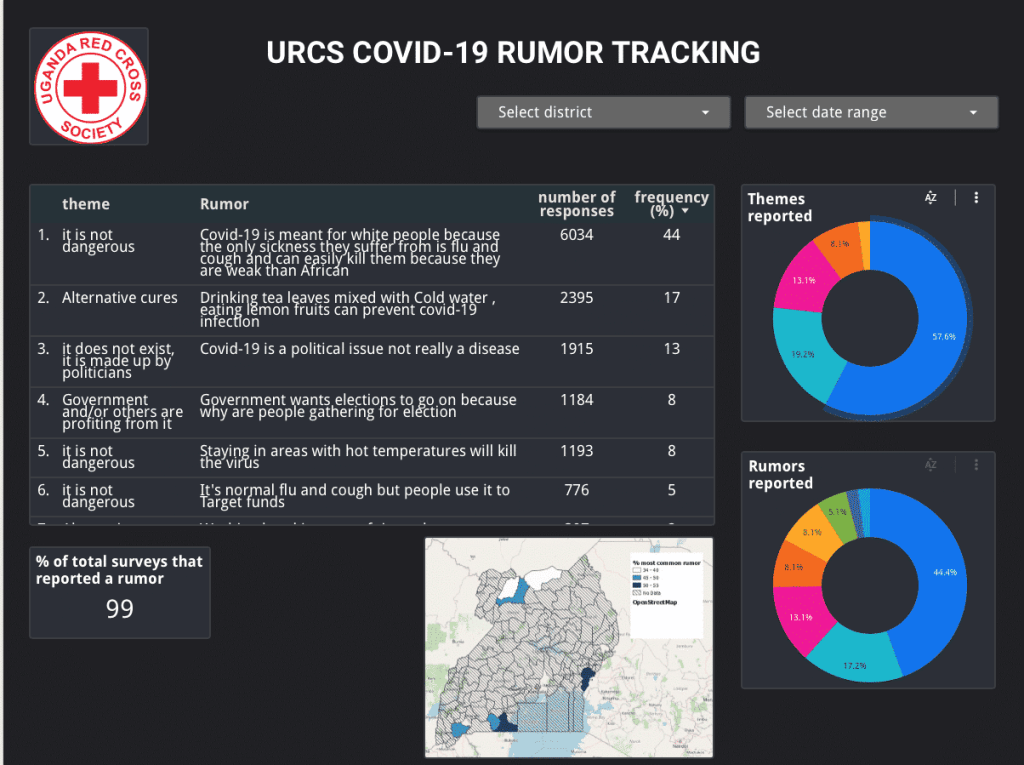What is a rumor? According to the Cambridge Dictionary, a rumor is “an unofficial interesting story or piece of news that might be true or invented, and quickly spreads from person to person”.
Nowadays, spreading speculations is not limited to one country or one population. Rumors are capable of reaching anyone due to the increased use of social media. With the COVID-19 pandemic, a surge of misinformation had circulated around the SARS-CoV-2 virus and more recently around the vaccines against it.
Red Cross and Red Crescent Societies have adapted their emergency response in many ways to ensure that their service delivery is not affected by the circumstances of the pandemic. One method that National Societies used to modify their response was by redesigning their risk communication strategy. At a time when COVID-19 was new, it was a crucial step for National Societies to integrate such new approaches addressing false rumors within communities.
Digitally collecting rumors
One approach that was widely seen in 2020 was shifting from manual to digital data collection. 510, being the data and digital initiative of the Netherlands Red Cross, was able to support various National Societies in making this change.
Jordan Red Crescent Society (JRCS) was looking for fast and efficient methods to include in their risk communication and engagement program. With the help of 510, JRCS decided to adopt digital tools that would assist in targeting and addressing rumors containing false information.
Ibrahim Al Ajlouni, the Head of Centre for First Aid at JRCS, said “we receive notice of a lot of rumors on a daily basis and it is important for us to catch the rumor at an early stage before it becomes big”.
Al Ajlouni then elaborated on the types of rumors that circulate by saying, “sometimes the rumor is about COVID-19 and other times it revolves around the work of the Red Crescent. They sometimes don’t even apply to Jordan, but because of the amount of misinformation shared on social media, it starts to spread in our country too”.
Rania Abdaldaiem, the Head of Communications and Public Relations Unit at JRCS, discussed the use of Kobo Collect in JRCS’ work. Kobo Collect is an open-source tool for mobile data collection. Abdaldaiem said “it is important that our community knows the nature and what Jordan Red Crescent represents; with the support from 510 on digitizing our data collection procedure using Kobo Collect, we now have the flexibility to develop the form that fits with our needs”.
Al Ajlouni then brought up another issue the KoBo collection tool was able to solve, “when our volunteers were collecting data regarding the vaccination programs, it would take too much time to address and validate all the data that was being gathered on paper. It would take so much time for the rumors to be brought to our attention and even longer to address them”.
Abdaldaiem then elaborated on why digitizing data collection was an important step taken in tracking rumors by saying, “we have the ability to allocate information at the beginning and are able to address it directly if any follow-up is needed; we need to interact fast, especially when dealing with rumors”.

Rumor visualization
Over 3,000km away from Jordan, the Uganda Red Cross Society (URCS) have also received support from 510 on adopting more digital tools, such as the development of a rumor tracking dashboard.
“Having a dashboard makes it easier to go forth with using the information on the data that was collected” said Arnold Ezama, URCS’ Community Epidemic and Pandemic Preparedness Program Officer, when talking about how the dashboard has helped with URCS’ work.
Ezama continued to say, “we were able to receive information directly from the field”. This information can be sorted, analyzed, and then visualized clearly on the rumor tracking dashboard.
When asked to share a main highlight of using this digital tool for the URCS’ COVID-19 service delivery, Ezama stated: “first, we were able to pick up data on disabilities, which has been a challenge for us in the past and second, we were able to gather data on age group distribution. The additional data not only improved our reporting but allowed us to assess and associate rumors to more specific indicators like age and location”.
Being able to sort the rumors by theme and visualize them on the dashboard assists the community preparedness team in planning targeted campaigns to address any misinformation. Switching to a more digital approach when collecting data seems to give National Societies the ability to make rapid and effective changes that can quickly vary depending on the need and purpose of a program.

Introducing digital tools and methods presents a prominent effect for the short and long term. The year 2020 presented National Societies with an opportunity to include more data and digital tools, with the support of 510, in their emergency response against COVID-19.
Many National Societies turned that opportunity into a reality and experienced how numerous digital tools were able to, in many ways, speed up their service delivery in the midst of the COVID-19 pandemic.

0 Comments